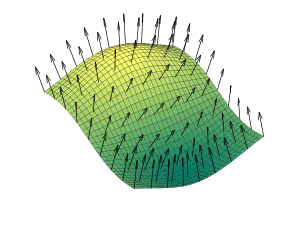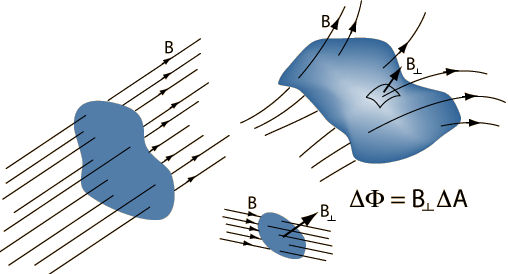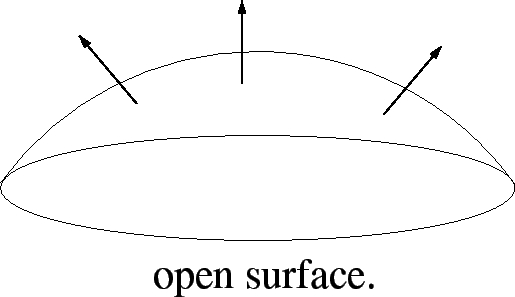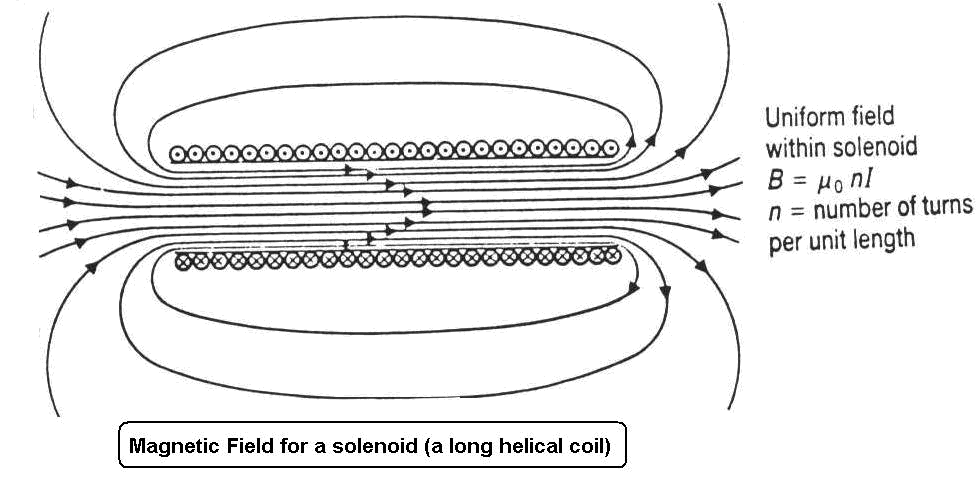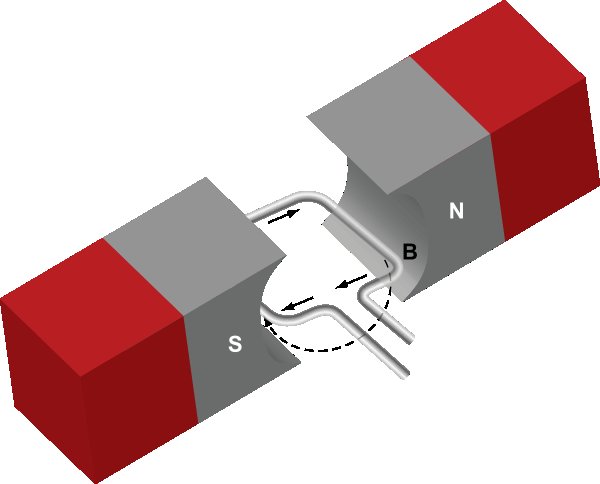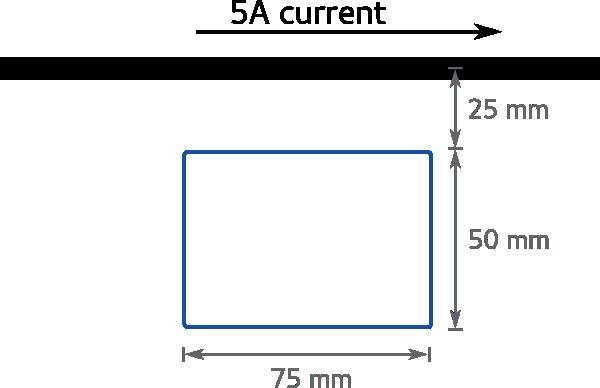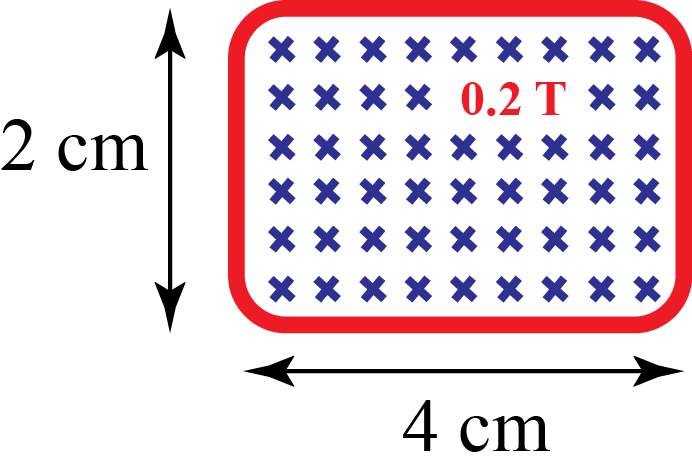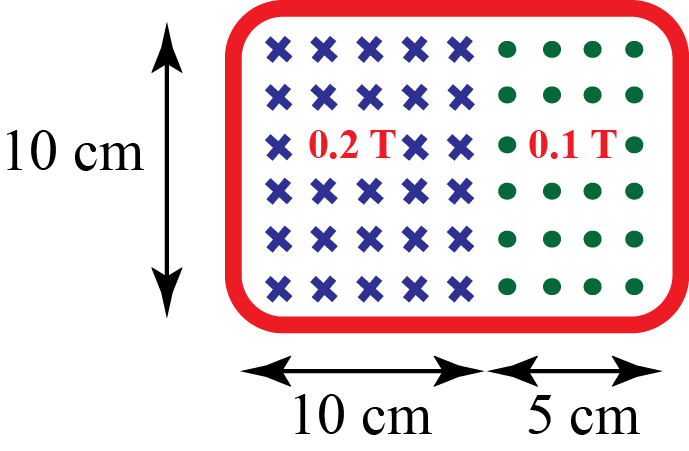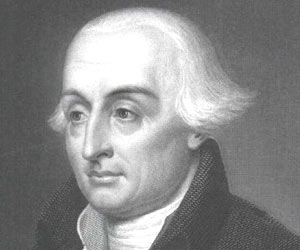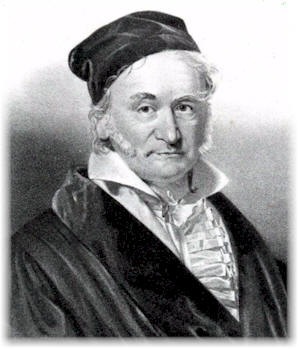Magnetic Flux: Difference between revisions
No edit summary |
No edit summary |
||
| (45 intermediate revisions by 4 users not shown) | |||
| Line 2: | Line 2: | ||
'''Claimed by Vansh Kareer (Fall 2017)''' | '''Claimed by Vansh Kareer (Fall 2017)''' | ||
'''Claimed by Davidson Poole (Spring 2018)''' | |||
'''Claimed by Jonathan Xue (Fall 2023)''' | |||
==The Main Idea== | ==The Main Idea== | ||
===A Mathematical Model=== | ===A Mathematical Model=== | ||
Recall that according to Gauss' law, the electric flux through any closed surface is directly proportional to the net electric charge enclosed by that surface. Given the very direct analogy which exists between an electric charge and a magnetic 'monopoles', we would expect to be able to formulate a second law which states that the magnetic flux through any closed surface is directly proportional to the number of magnetic monopoles enclosed by that surface. But the problem is that magnetic monopoles don't exist. It follows that the equivalent of Gauss' law for magnetic fields reduces to: | To put in simple terms, magnetic flux is the amount of magnetic field going through a given area in a singular instant of time. Whether the area is non uniform, or if the magnetic field isn't constant, you can use the magnetic flux formula to calculate the number of Teslas in the given area. | ||
As stated, this page is only considering magnetic flux, which doesn't incorporate time. Faraday's Law however, takes the concept of magnetic flux and uses time to quantify electromotive forces [https://www.physicsbook.gatech.edu/Faraday%27s_Law]. | |||
Recall that according to Gauss's law, the electric flux through any closed surface is directly proportional to the net electric charge enclosed by that surface. Given the very direct analogy which exists between an electric charge and a magnetic 'monopoles', we would expect to be able to formulate a second law which states that the magnetic flux through any closed surface is directly proportional to the number of magnetic monopoles enclosed by that surface. But the problem is that magnetic monopoles don't exist. It follows that the equivalent of Gauss's law for magnetic fields reduces to: | |||
<math>\Phi_B = \oint B \cdot dA = 0</math> | <math>\Phi_B = \oint B \cdot dA = 0</math> | ||
Realistically, the magnetic flux though any CLOSED surface is zero. The magnetic flux through an area will be its own individual value. This rule is useful when solving for a an unknown magnetic field that's coming from a side of a surface when the other fields from the other sides are known. Magnetic flux is measured in SI units of Weber ( | Note- The integral sign with a circle in the middle is commonly used in electromagnetism, and it represents a "closed integral" for the entirety of a surface or object. | ||
Realistically, the magnetic flux though any CLOSED surface is zero. This is because magnetic field lines are continuous loops. This means that if there is a non-zero magnetic field through the top face of a cube for example, the entering magnetic field from the bottom face will cancel out the top one. The magnetic flux through an area will be its own individual value. This rule is useful when solving for a an unknown magnetic field that's coming from a side of a surface when the other fields from the other sides are known. Magnetic flux is measured in SI units of Weber (Wb), named after German physicist and co-inventor of the telegraph Wilhelm Weber. A Weber is equal to T*m^2. | |||
This is the Gauss's law general form for finding magnetic flux through an area (through a non-closed surface). | |||
<math>\Phi_B = \int B \cdot dA </math> | |||
To fully understand the meaning of this equation, an understanding of normal vectors and dot products is required. Relative to a surface, a normal vector runs perpendicular to the surface at a certain point. Note that the normal vector also typically faces outwards. For curved surfaces, such as the one shown below, there normal vectors changes its orientation depending on the angle of each plane of the surface. | |||
[[File:normalvectors.png]] | |||
Thus Gauss's law for magnetic flux can be expanded via the dot product definition, where theta is the angle between the plane of the surface area and the vector of magnetic field at that location. | |||
Computing dot product: | |||
<math> < B_x,B_y,B_z> \cdot < A_x,A_y,A_z> = B_x*A_x + B_y*A_y + B_z*A_z</math> | |||
<math>\Phi_B = \oint B \cdot dA =\oint B * dA * cos(\theta)</math> | |||
===A Computational Model=== | ===A Computational Model=== | ||
| Line 19: | Line 45: | ||
Solenoid: [[File:solenoidsingi.gif]] | Solenoid: [[File:solenoidsingi.gif]] | ||
==Further Description== | ==Further Description== | ||
Gauss's Law for magnetism tells us that magnetic monopoles do not exist. If magnetic monopoles existed, they would be sources and sinks of the magnetic field, and therefore the right-hand side could differ from zero. Gauss's Law for magnetism is one of the four Maxwell's equations, which form the foundation for the entire theory of classical electrodynamics. | Gauss's Law for magnetism tells us that magnetic monopoles do not exist. Scientists have searched and searched for one, but none have been found. In fact it it does not work with any of the laws of electromagnetism. If magnetic monopoles existed, they would be sources and sinks of the magnetic field, and therefore the right-hand side could differ from zero. Gauss's Law for magnetism is one of the four Maxwell's equations, which form the foundation for the entire theory of classical electrodynamics. | ||
The magnitude of the magnetic flux depends on the strength of the magnetic field, the size of the surface area, and the angle between the direction in which the surface area points and the direction of the magnetic field (the definition of a dot-product; only the component of the magnetic field | The magnitude of the magnetic flux depends on the strength of the magnetic field, the size of the surface area, and the angle between the direction in which the surface area points and the direction of the magnetic field (the definition of a dot-product; only the component of the magnetic field normal to the surface is considered). The charges outside contribute zero net flux, so we can ignore them. | ||
[[File:MagFlux.gif]] | [[File:MagFlux.gif]] | ||
As stated before, another of Maxwell's equations, Gauss's Law for electric fields, concerns electric field flux. | |||
<math>\Phi_E = \iint_S E \cdot dS = \dfrac{Q}{\epsilon_0}</math> | |||
Here, <math>\Phi_E </math> represents electric field flux, E represent the electric field present, S represents the closed surface area being considered, Q is the total electric charge encompassed by the surface area, and <math>\epsilon_0</math> is the electric constant (known as the permittivity of free space). Thus, the electric field through a closed surface area is not always zero, unlike the magnetic flux through a closed surface, which is zero due to the lack of existence of magnetic monopoles. This electric field flux equation is the opposite of Gauss's law for magnetic flux, indicating the importance of electric monopoles (free positive and negative charges) to electric field flux. | |||
==Applications== | |||
Magnetic flux is very closely related to electric flux using Gauss's law for electric fields (one of the four Maxwell equations). | |||
There are a few important real-world applications of magnetic flux. As described by Faraday's Law, when a coiled wire moves through a magnetic field, a voltage is produced. This voltage is dependent on the magnetic flux (due to the surrounding magnetic field) through the area of the coiled wire, as seen below. Additionally, whenever the magnetic flux changes, an electric field is made. For example, if a square wire changes area inside of a magnetic field, it can cause a current to run through the wire. Of course, this is a later unit and can be explored through [[Faraday's Law]]. | |||
At the present, there are several applications of magnetic flux that we use on a day to day basis. The first thing someone might think about is the usage of flux as a way detect magnetic fields through certain surfaces. Magnetic sensors do just that: they can be used to measure the output of a magnetic field. You can also detect and sense current readings using a galvanometer. There have also been recent studies that utilise magnetic flux for pipe leakage detection [https://www.mdpi.com/1424-8220/15/12/29845], and the usage of magnetic flux is strongly linked to induction, so an induction stove also uses the properties of magnetic flux for cooking. | |||
[[File:FluxinMagField.jpg]] | |||
Via the Faraday-Lenz law, engineers can easily calculate the voltage generated by a coiled wire in a magnetic field. The relationship is electro-motive force equals the negative rate of change of magnetic flux over time. | |||
<math>\epsilon = -\dfrac{d\Phi}{dt} </math> | |||
==Practice Problems== | ==Practice Problems== | ||
| Line 39: | Line 82: | ||
Advanced Walkthrough: [https://www.youtube.com/watch?v=ba8ADUeGd9w] | Advanced Walkthrough: [https://www.youtube.com/watch?v=ba8ADUeGd9w] | ||
Once you get the hang of the process of solving magnetic flux problems using the walkthroughs, then move on to the more advanced questions below. | Once you get the hang of the process of solving magnetic flux problems using the walkthroughs, try some of the basic questions, then move on to the more advanced questions below. | ||
===Basic=== | |||
1) As shown below, there a current-carrying wire alongside a coil of wire. Using Gauss's Law, calculate the magnitude of magnetic flux through the coil of wire. [Question from Khan Academy; solution through link below] | |||
[[File:FluxEx1.jpg]] | |||
2) Calculate the magnetic flux through the coiled wire given the magnetic field present. | |||
[[File:FluxEx2.png]] | |||
3) Calculate the magnetic flux through the coiled wire given the magnetic fields present. | |||
[[File:FluxEx3.png]] | |||
4) A wire of resistance 7 ohms and length 3.8 m is bent into a circle and is concentric with a solenoid in which the magnetic flux changes from 5 T·m2 to 3 T·m2 in 0.2 seconds. What is the emf in the wire? | |||
===Advanced=== | ===Advanced=== | ||
| Line 48: | Line 107: | ||
3) A square with side length T is directly facing the xy plane 3 meters away from a current carrying 1 meter wire (from a portion of a nearby circuit powered by a battery with an emf of U). The wire is aligned with the y axis. The magnetic flux going through the square is G. Find the resistance of the wire. | 3) A square with side length T is directly facing the xy plane 3 meters away from a current carrying 1 meter wire (from a portion of a nearby circuit powered by a battery with an emf of U). The wire is aligned with the y axis. The magnetic flux going through the square is G. Find the resistance of the wire. | ||
== | ==Solutions== | ||
===Basic=== | |||
1) Khan Academy: [https://www.khanacademy.org/science/physics/magnetic-forces-and-magnetic-fields/magnetic-flux-faradays-law/a/what-is-magnetic-flux] | |||
2) Use the base form of Gauss's Law of magnetic flux. | |||
<math>\Phi_B = \oint B \cdot dA </math> | |||
<math>dA=0.02 m *0.04 m= 0.0008 m^2</math> | |||
<math>\Phi_B = \oint B \cdot dA=0.2 T * 0.0008 m^2= 0.00016 T*m^2=0.00016 Wb</math> | |||
3) Here, employ the same method as the last problem, but remember that the two magnetic fields run in opposite directions. | |||
<math>\Phi_B = \oint B \cdot dA </math> | |||
<math>dA=0.1 m *0.15 m= 0.015 m^2</math> | |||
<math>\Phi_B = \oint B \cdot dA=(0.2-0.1) T * 0.015 m^2= 0.0015 T*m^2=0.0015 Wb</math> | |||
4) Recall that magnitude of electro-motive force equals the change in magnetic flux over time. | |||
<math>\epsilon = \dfrac{d\Phi}{dt} </math> | |||
<math>\ | <math>\epsilon = \dfrac{(5 T*m^2-3 T*m^2)}{(0.2 s)} = 10 V </math> | ||
==History== | ==History== | ||
| Line 63: | Line 137: | ||
Prior to Gauss's study on the subject however, Joseph-Louis Lagrange (famous Italian mathematician) had studied the subject. However, Gauss completed the formulation of the theory and published it in 1813. | Prior to Gauss's study on the subject however, Joseph-Louis Lagrange (famous Italian mathematician) had studied the subject. However, Gauss completed the formulation of the theory and published it in 1813. | ||
It is also important to note that while Gauss's Law establishes the magnetic flux through a closed surface, Faraday's Law establishes the magnetic flux through an open surface. | |||
Lagrange: [[File:lgsingi.jpg]] | Lagrange: [[File:lgsingi.jpg]] | ||
Gauss: [[File:gsingi.jpg]] | Gauss: [[File:gsingi.jpg]] | ||
==Further Reading== | ==Further Reading== | ||
| Line 81: | Line 158: | ||
In-Depth Explanation: [https://www.youtube.com/watch?v=1RcpSUr8GtA] | In-Depth Explanation: [https://www.youtube.com/watch?v=1RcpSUr8GtA] | ||
Another Problem: [http://physicstasks.eu/552/magnetic-flux-through-a-square] | |||
==References== | ==References== | ||
Pictures: [http://hyperphysics.phy-astr.gsu.edu/hbase/magnetic/fluxmg.html] | Pictures: [http://hyperphysics.phy-astr.gsu.edu/hbase/magnetic/fluxmg.html] | ||
| Line 94: | Line 174: | ||
Picture: [https://ka-perseus-images.s3.amazonaws.com/b5a3d44ae79a1f1a298d8e9c4952f47c940e0567.svg] | Picture: [https://ka-perseus-images.s3.amazonaws.com/b5a3d44ae79a1f1a298d8e9c4952f47c940e0567.svg] | ||
Picture: [https://ka-perseus-images.s3.amazonaws.com/bfc3a0cdf4a86d74832e68cdd9a2eeb6a320da15.svg] | |||
Picture: [http://www.solvephysics.com/magnetism_prob23a.png] | |||
Picture: [http://www.solvephysics.com/magnetism_prob24a.png] | |||
WebAssign Instructional Application for PHYS 2212, Georgia Institute of Technology. | |||
Resource : [http://www.solvephysics.com/topic_magnetic_flux_induction.shtml] | |||
Resource: [https://en.wikipedia.org/wiki/Magnetic_flux] | |||
Picture: [https://upload.wikimedia.org/wikipedia/commons/thumb/c/cc/Surface_normals.svg/300px-Surface_normals.svg.png] | |||
Latest revision as of 16:23, 26 November 2023
Claimed by Rahul Singi (Spring 2017)
Claimed by Vansh Kareer (Fall 2017)
Claimed by Davidson Poole (Spring 2018)
Claimed by Jonathan Xue (Fall 2023)
The Main Idea
A Mathematical Model
To put in simple terms, magnetic flux is the amount of magnetic field going through a given area in a singular instant of time. Whether the area is non uniform, or if the magnetic field isn't constant, you can use the magnetic flux formula to calculate the number of Teslas in the given area. As stated, this page is only considering magnetic flux, which doesn't incorporate time. Faraday's Law however, takes the concept of magnetic flux and uses time to quantify electromotive forces [1].
Recall that according to Gauss's law, the electric flux through any closed surface is directly proportional to the net electric charge enclosed by that surface. Given the very direct analogy which exists between an electric charge and a magnetic 'monopoles', we would expect to be able to formulate a second law which states that the magnetic flux through any closed surface is directly proportional to the number of magnetic monopoles enclosed by that surface. But the problem is that magnetic monopoles don't exist. It follows that the equivalent of Gauss's law for magnetic fields reduces to:
[math]\displaystyle{ \Phi_B = \oint B \cdot dA = 0 }[/math]
Note- The integral sign with a circle in the middle is commonly used in electromagnetism, and it represents a "closed integral" for the entirety of a surface or object.
Realistically, the magnetic flux though any CLOSED surface is zero. This is because magnetic field lines are continuous loops. This means that if there is a non-zero magnetic field through the top face of a cube for example, the entering magnetic field from the bottom face will cancel out the top one. The magnetic flux through an area will be its own individual value. This rule is useful when solving for a an unknown magnetic field that's coming from a side of a surface when the other fields from the other sides are known. Magnetic flux is measured in SI units of Weber (Wb), named after German physicist and co-inventor of the telegraph Wilhelm Weber. A Weber is equal to T*m^2.
This is the Gauss's law general form for finding magnetic flux through an area (through a non-closed surface).
[math]\displaystyle{ \Phi_B = \int B \cdot dA }[/math]
To fully understand the meaning of this equation, an understanding of normal vectors and dot products is required. Relative to a surface, a normal vector runs perpendicular to the surface at a certain point. Note that the normal vector also typically faces outwards. For curved surfaces, such as the one shown below, there normal vectors changes its orientation depending on the angle of each plane of the surface.
Thus Gauss's law for magnetic flux can be expanded via the dot product definition, where theta is the angle between the plane of the surface area and the vector of magnetic field at that location.
Computing dot product:
[math]\displaystyle{ \lt B_x,B_y,B_z\gt \cdot \lt A_x,A_y,A_z\gt = B_x*A_x + B_y*A_y + B_z*A_z }[/math]
[math]\displaystyle{ \Phi_B = \oint B \cdot dA =\oint B * dA * cos(\theta) }[/math]
A Computational Model
As seen on the formula described on the section above, the magnetic flux of an object depends on the size and shape of the object. Therefore, it is hard to show one specific computational model that can correctly illustrate magnetic flux. However, below are some images that show the magnetic flux of three common types of surfaces: closed, open, and solenoid.
Further Description
Gauss's Law for magnetism tells us that magnetic monopoles do not exist. Scientists have searched and searched for one, but none have been found. In fact it it does not work with any of the laws of electromagnetism. If magnetic monopoles existed, they would be sources and sinks of the magnetic field, and therefore the right-hand side could differ from zero. Gauss's Law for magnetism is one of the four Maxwell's equations, which form the foundation for the entire theory of classical electrodynamics.
The magnitude of the magnetic flux depends on the strength of the magnetic field, the size of the surface area, and the angle between the direction in which the surface area points and the direction of the magnetic field (the definition of a dot-product; only the component of the magnetic field normal to the surface is considered). The charges outside contribute zero net flux, so we can ignore them.
As stated before, another of Maxwell's equations, Gauss's Law for electric fields, concerns electric field flux.
[math]\displaystyle{ \Phi_E = \iint_S E \cdot dS = \dfrac{Q}{\epsilon_0} }[/math]
Here, [math]\displaystyle{ \Phi_E }[/math] represents electric field flux, E represent the electric field present, S represents the closed surface area being considered, Q is the total electric charge encompassed by the surface area, and [math]\displaystyle{ \epsilon_0 }[/math] is the electric constant (known as the permittivity of free space). Thus, the electric field through a closed surface area is not always zero, unlike the magnetic flux through a closed surface, which is zero due to the lack of existence of magnetic monopoles. This electric field flux equation is the opposite of Gauss's law for magnetic flux, indicating the importance of electric monopoles (free positive and negative charges) to electric field flux.
Applications
Magnetic flux is very closely related to electric flux using Gauss's law for electric fields (one of the four Maxwell equations).
There are a few important real-world applications of magnetic flux. As described by Faraday's Law, when a coiled wire moves through a magnetic field, a voltage is produced. This voltage is dependent on the magnetic flux (due to the surrounding magnetic field) through the area of the coiled wire, as seen below. Additionally, whenever the magnetic flux changes, an electric field is made. For example, if a square wire changes area inside of a magnetic field, it can cause a current to run through the wire. Of course, this is a later unit and can be explored through Faraday's Law.
At the present, there are several applications of magnetic flux that we use on a day to day basis. The first thing someone might think about is the usage of flux as a way detect magnetic fields through certain surfaces. Magnetic sensors do just that: they can be used to measure the output of a magnetic field. You can also detect and sense current readings using a galvanometer. There have also been recent studies that utilise magnetic flux for pipe leakage detection [2], and the usage of magnetic flux is strongly linked to induction, so an induction stove also uses the properties of magnetic flux for cooking.
Via the Faraday-Lenz law, engineers can easily calculate the voltage generated by a coiled wire in a magnetic field. The relationship is electro-motive force equals the negative rate of change of magnetic flux over time.
[math]\displaystyle{ \epsilon = -\dfrac{d\Phi}{dt} }[/math]
Practice Problems
Walkthroughs
Simple Walthrough:[3]
Middling Walkthrough: [4]
Advanced Walkthrough: [5]
Once you get the hang of the process of solving magnetic flux problems using the walkthroughs, try some of the basic questions, then move on to the more advanced questions below.
Basic
1) As shown below, there a current-carrying wire alongside a coil of wire. Using Gauss's Law, calculate the magnitude of magnetic flux through the coil of wire. [Question from Khan Academy; solution through link below]
2) Calculate the magnetic flux through the coiled wire given the magnetic field present.
3) Calculate the magnetic flux through the coiled wire given the magnetic fields present.
4) A wire of resistance 7 ohms and length 3.8 m is bent into a circle and is concentric with a solenoid in which the magnetic flux changes from 5 T·m2 to 3 T·m2 in 0.2 seconds. What is the emf in the wire?
Advanced
1) There is a small bar magnet with a magnetic dipole D located at the origin (0,0,0). It's aligned with the y-axis. There is a circular disk with a radius of R facing perpendicular to the yz plane and its center is 4 meters away on the +x axis from the bar magnet. What is the magnetic flux going through the disk in terms of the given variable? (Consult with your professor for the solution).
2) Referring back to the previous problem, the disk is now tilted so that the angle between the yz plane and the surface is 30 degrees. Find the new magnetic flux in terms of the given variables.
3) A square with side length T is directly facing the xy plane 3 meters away from a current carrying 1 meter wire (from a portion of a nearby circuit powered by a battery with an emf of U). The wire is aligned with the y axis. The magnetic flux going through the square is G. Find the resistance of the wire.
Solutions
Basic
1) Khan Academy: [6]
2) Use the base form of Gauss's Law of magnetic flux.
[math]\displaystyle{ \Phi_B = \oint B \cdot dA }[/math]
[math]\displaystyle{ dA=0.02 m *0.04 m= 0.0008 m^2 }[/math]
[math]\displaystyle{ \Phi_B = \oint B \cdot dA=0.2 T * 0.0008 m^2= 0.00016 T*m^2=0.00016 Wb }[/math]
3) Here, employ the same method as the last problem, but remember that the two magnetic fields run in opposite directions.
[math]\displaystyle{ \Phi_B = \oint B \cdot dA }[/math]
[math]\displaystyle{ dA=0.1 m *0.15 m= 0.015 m^2 }[/math]
[math]\displaystyle{ \Phi_B = \oint B \cdot dA=(0.2-0.1) T * 0.015 m^2= 0.0015 T*m^2=0.0015 Wb }[/math]
4) Recall that magnitude of electro-motive force equals the change in magnetic flux over time.
[math]\displaystyle{ \epsilon = \dfrac{d\Phi}{dt} }[/math]
[math]\displaystyle{ \epsilon = \dfrac{(5 T*m^2-3 T*m^2)}{(0.2 s)} = 10 V }[/math]
History
A major part of the history of magnetic flux is tied to Carl Freidrich Gauss. Gauss was a 19th century German physicist and mathematician that had notable contributions in not only the world of physics but across the fields of algebra, astronomy, and geometry. However, in this course, he is mainly known for the introduction of one of the four Maxwell's Laws(partial differential equations), titled Gauss's Law which describes the equation used to calculate magnetic flux.
Prior to Gauss's study on the subject however, Joseph-Louis Lagrange (famous Italian mathematician) had studied the subject. However, Gauss completed the formulation of the theory and published it in 1813.
It is also important to note that while Gauss's Law establishes the magnetic flux through a closed surface, Faraday's Law establishes the magnetic flux through an open surface.
Further Reading
What is Magnetic Flux?: [7]
Overview: [8]
In-Depth Tutorial: [9]
Helpful Links/Videos
Khan Academy: [10]
Quick Explanation: [11]
In-Depth Explanation: [12]
Another Problem: [13]
References
Pictures: [14]
Pictures: [15]
Pictures: [16]
Pictures: [17]
Pictures: [18]
Picture: [19]
Picture: [20]
Picture: [21]
Picture: [22]
WebAssign Instructional Application for PHYS 2212, Georgia Institute of Technology.
Resource : [23]
Resource: [24]
Picture: [25]
